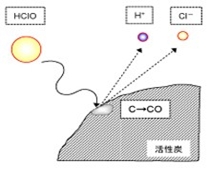Tech & Tools
Technical information
- HOME
- Tech & Tools
- Removal of free residual chlorine with activated carbon
Removal of free residual chlorine with activated carbon
The mechanism for removing residual chlorine from activated carbon will be explained.
Unlike organic substances, residual chlorine is not only adsorbed on activated carbon, but also decomposed into chlorine ions. Therefore, at first glance, it seems that it can be treated permanently, but as shown in the figure below, the activated carbon is oxidized, and if all the activated carbon is oxidized, the effect is lost. However, the specific surface area of activated carbon is several thousand.m2Unlike adsorption, its effect is not lost in a short period of time.

(1) Residual chlorine (HClO, etc.) comes into contact with activated carbon.
(2) Residual chlorine is decomposed into hydrogen ions and chlorine ions. At that time, the surface of the activated carbon is oxidized.
When removing residual chlorine, the surface of activated carbon is oxidized as shown in the figure and deteriorates over time. Therefore, we recommend the use of TA-30N, which has high strength.
Head Office
1-12-11 Tagawakita, Yodogawa-ku,Osaka
532-0021
Overseas Business Department
TEL +81-6-6301-6460
FAX +81-6-6308-3022




